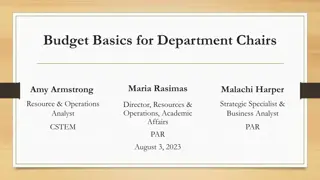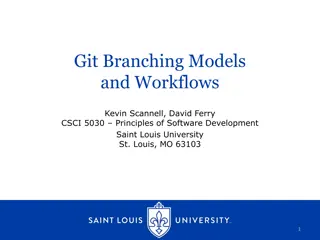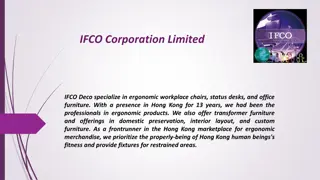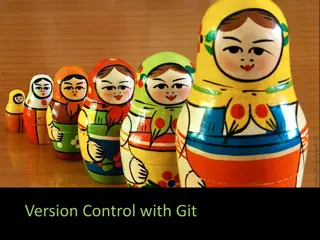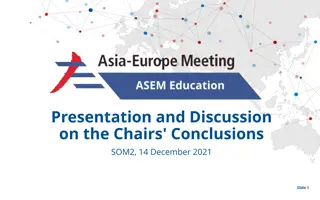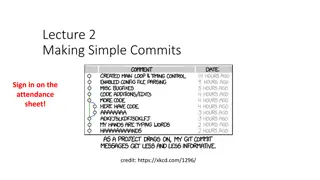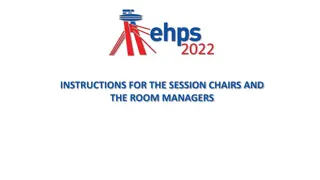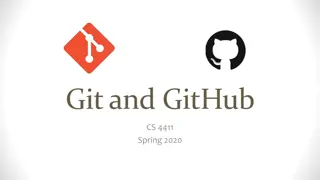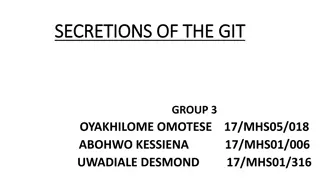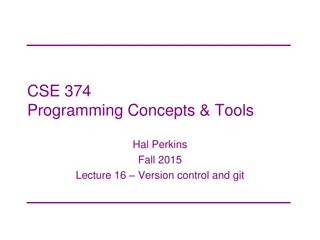
Implementing DEIJ Strategy in Chesapeake Bay Watershed Agreement
Learn how the DEIJ strategy was developed, the commitments made in the PSC Action Statement, and the vision of the DEIJ Action Team towards ensuring environmental justice and diversity in conservation efforts within the Chesapeake Bay Watershed Agreement by 2025.
Download Presentation

Please find below an Image/Link to download the presentation.
The content on the website is provided AS IS for your information and personal use only. It may not be sold, licensed, or shared on other websites without obtaining consent from the author. If you encounter any issues during the download, it is possible that the publisher has removed the file from their server.
You are allowed to download the files provided on this website for personal or commercial use, subject to the condition that they are used lawfully. All files are the property of their respective owners.
The content on the website is provided AS IS for your information and personal use only. It may not be sold, licensed, or shared on other websites without obtaining consent from the author.
E N D
Presentation Transcript
1 Kristin Saunders (UMCES) Bo Williams (EPA) DEIJ Action Team Goal Team Chairs and Leadership Meeting 3-31-21
2 Diversity and Environmental Justice in 2014 Chesapeake Bay Watershed Agreement Diversity Outcome: Identify stakeholder groups that are not currently represented in the leadership, decision making and implementation of conservation and restoration activities and create meaningful opportunities and programs to recruit and engage them in the partnership s efforts. EJ Principle: Promote environmental justice through the meaningful involvement and fair treatment of all people, regardless of race, color, national origin or income in the implementation of this Agreement.
3 HOW WAS THE DEIJ STRATEGY DEVELOPED? 1) EPA-funded project awarded to independent consultant 2) DEIJ Readiness Assessment of CBP Interviews Focus Groups Survey Review of policy documents 3) Draft DEIJ Strategy developed and reviewed by Diversity Workgroup before finalized in April 2020 - - - -
4 The five commitments in the PSC Action Statement
5 5 PSC ACTION STATEMENT COMMITMENTS To implement the recommendations in the DEIJ Strategy, the PSC commits to: Within six months of the signing of the Chesapeake Executive Council statement, a draft implementation plan for the DEIJ Strategy will be presented to the PSC. The development of this plan will include direct outreach to underrepresented communities for input and feedback. Within three months of the signing of the Chesapeake Executive Council statement, explore a process for a community advisory board composed of environmental justice leaders and representatives from organizations led by people of color or other underrepresented groups. This board could be part of one of the partnership s existing advisory boards (Citizens Advisory Committee or Local Government Advisory Committee). 1. 2.
6 5 PSC ACTION STATEMENT COMMITMENTS Advancement of the DEIJ Strategy through work plan development and implementation for all GITs and Workgroups on their respective strategy review system schedules. Meaningful inclusion of DEIJ milestones on the agendas for the Management Board and PSC meetings at a minimum every six months with a commitment to update the Chesapeake Executive Council annually. Meaningful consideration of DEIJ in development of any future Chesapeake Bay Watershed Agreement(s). 3. 4. 5.
7 DEIJ Action Team Vision DEIJ Strategy Implementation Plan Develop roadmap for implementing DEIJ Strategy Action Plan, identifying additional actions, subtasks, steps, and resources needed to ensure implementation by end of 2025. Community Advisory Board Develop recommendations for establishing a Community Advisory Board composed environmental justice leaders and representatives from underrepresented groups, identifying feasible options for board purpose, structure, membership, governance, funding/compensation, timing, etc. Outreach and Communications Engage underrepresented communities in the development of the implementation plan and recommendations for the Community Advisory Board. Use the engagement process as a foundation for organizational change and meaningful and long-term engagement with underrepresented communities.
8 DEIJ Strategy Focus Areas Strengthening CBP s Authorizing Environment for DEIJ >Objective 1: Create an authorizing environment for DEIJ Advancing DEIJ Internally >Objective 2: Increase DEIJ in hiring, promotion and tenure >Objective 3: Increase DEIJ in appointee and volunteer bodies >Objective 4: Increase DEIJ in internal culture and training Advancing DEIJ through Watershed Restoration Work >Objective 5: Advance DEIJ through GIT workplans and outcomes >Objective 6: Advance DEIJ through communications >Objective 7: Advance DEIJ through grant-making and contracting Advancing DEIJ Performance of CBP Partners >Objective 8: Increase DEIJ Performance of Partners
9 DEIJ Strategy: Actions Strengthening CBP s Authorizing Environment for DEIJ >Objective 1: Create an authorizing environment for DEIJ Action 1.2 Update the Management Strategies, as needed, to explicitly articulate the roles of diversity, equity, inclusion and environmental justice in achieving CBP s mission and guiding implementation of the agreement. Action 1.4: Update the Governance Document for the Chesapeake Bay Partnership to include a) explicit diversity goals for each group in their Leadership and Membership sections, b) language describing the role and impact of DEI and EJ considerations in the Process for Decision-Making section, and c) mechanisms for raising and addressing DEI issues Action 1.7: Establish protocol for tracking and reporting measures of success for all actions to include: 1) clear list and definitions of metrics for tracking; 2) protocols and time interval for measuring progress; 3) define baseline status; 4) define reporting structure
10 How do we best track and report progress on implementing the plan and and track and report elements of DEIJ work within your goal team plans? What do you consider measures of success? Click to add text
11 DEIJ Implementation Plan: Example Strengthening CBP s Authorizing Environment for DEIJ >Objective 1: Create an authorizing environment for DEIJ Action 1.2 Update the Management Strategies, as needed, to explicitly articulate the roles of diversity, equity, inclusion and environmental justice in achieving CBP s mission and guiding implementation of the agreement. Subtask 1: Draft general language based on DEIJ Statement for incorporation in all Management Strategies (assigned to GIT 6 to complete before beginning of third SRS cycle) Subtask 2: Recommend Outcome-specific language for incorporation into each Management Strategy as it comes up for SRS review. Include goals identified by Presidential Executive Orders as applicable. (Assigned to Outcome leads to complete during the QPR process) Subtask 3: Review and approval of final language for incorporation into Management Strategies (Assigned to MB).
12 What help do you need to make this happen?
13 DEIJ Strategy: Actions Advancing DEIJ through Watershed Restoration Work Objective 5: Advance DEIJ through GIT workplans and outcomes Objective 6: Advance DEIJ through communications Objective 7: Advance DEIJ through grant-making and contracting 3.2: Build relationships with communities of color, low-income communities, and other underrepresented groups, and incorporate these leaders into decision-making and implementation. Action 3.2.a. Participate in EJ-led gatherings, such as ongoing engagement in the University of Maryland School of Public Health DMV EJ conference (consider becoming a sponsor) to build CBP s professional network and bring discussion about implementation of the Chesapeake Bay Watershed Agreement directly into EJ- led spaces. .
14 What help do you need to make this happen? Click to add text
15 3.3: Advance DEI through GIT workplan development and implementation Action 3.3.a. Identify specific decision-points and other milestones within the GIT workplans and other governance and management processes supporting the development and implementation of the Chesapeake Bay Watershed Agreement, where communities of color, low-income communities and other underrepresented groups can influence the development and implementation of the Chesapeake Bay Watershed Agreement. Action 3.3.b. Review each GIT workplan and ensure inclusion of considerations for equitable distribution of benefits and improvements and considerations for reduction of disproportionate adverse environmental impacts in communities of color, low- income communities and other underrepresented groups. Action 3.3.c Ensure implementation partnerships include (1) organizations that are run by and primarily serve communities of color and other underrepresented communities and (2) other organizations that engage these communities. In the near- term, place an emphasis on increasing the former, as the groups are currently underrepresented in CBP s partnerships.
16 Coordination? GIT6 or Diversity workgroup have authority to make it happen? Should Diversity workgroup be where reporting occurs rather than implementation? Best way to ensure work is happening within each goal team? Should it be an SRS factor everyone addresses in the logic and action plan? Or better as a question in the narrative analysis? Would it be better to apply the lens of DEIJ across all actions? Timing all in one fell swoop or phased in over each quarterly progress? What are you doing now and how do we capture that information? Gaps: how and who of outreach? 16
17 Community Advisory Board Current Status The DEIJ Action Team developed initial recommendations and options for establishment of CAB and presented this to the PSC on March 2nd Recommendations included areas for consideration: 1. Appointing Authorities 2. Size of Board 3. Expectations of Role 4. Budget/Funding Sources Some PSC members raised concerns about creating a CAB that is separate from other CBP Advisory Committees The PSC requested that at a future meeting they receive an update on the Diversity Workgroup GIT Funding project, "Cultivating and Strengthening Relationships with Underrepresented Stakeholder Groups."
18 Outreach & Communications DEIJ Action Team has developed a Communications/Outreach plan and schedule to guide internal and external outreach. February-April: Internal CBP feedback and information gathering with Action Team, Diversity Workgroup, and YOU TODAY March-Summer: Direct engagement with underrepresented communities via Action Team members and partner networks (including tracking); public comment period external review and comments. Develop stakeholder list with input from Action Team members. Efforts will build on the work of the CBP Communications Office and Diversity Workgroup who will help refine messaging and develop outreach materials. Diversity Workgroup GIT funded project , Cultivating and Strengthening Relationships with Underrepresented Stakeholders Bay Program Primers: Who We Are. What We do. 18
19 Outreach & Communications Vision: Engage underrepresented communities in the development of the implementation plan and recommendations for the Community Advisory Board. Use the engagement process as a foundation for organizational change and meaningful and long-term engagement with underrepresented communities How do we define Meaningful Engagement/Involvement ? People have an opportunity to participate in decisions about activities that may affect their environment and/or health. The public's contribution may influence the decision Community concerns will be considered in the decision-making process Decision makers will seek out and facilitate the involvement of those potentially affected



